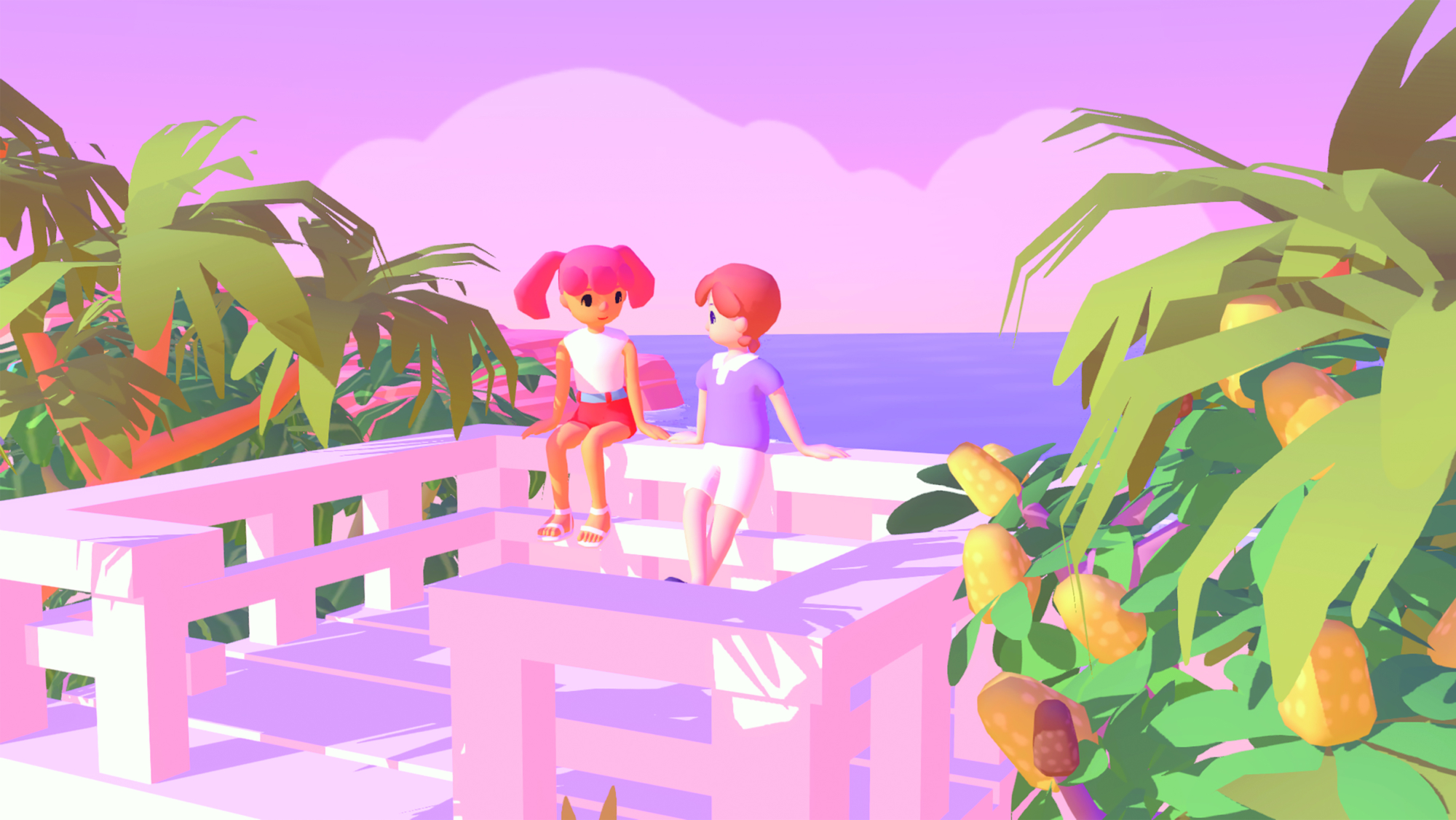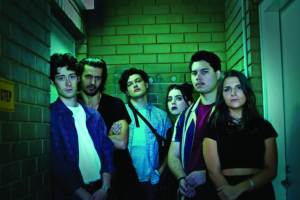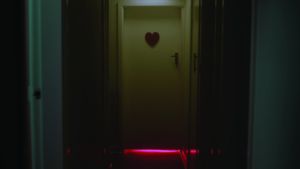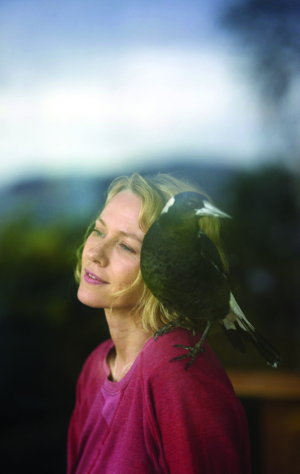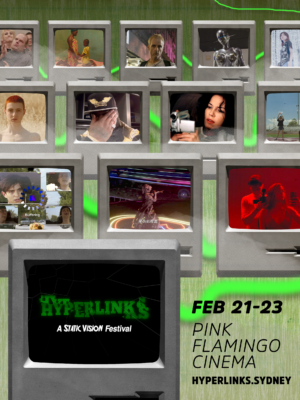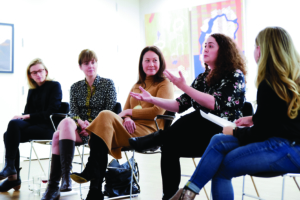In Olivia Haines’ upcoming locally produced videogame Surf Club, players explore a small coastal town – in the process, discovering its secret spaces and becoming familiar with its cast of locals – through its protagonist, Holly, a young woman returning to the place where she grew up after a long absence in order to rekindle a teenage relationship. The game offers a low-key environment in which contemplation of memory and change is prioritised; in Haines’ words, players are transported ‘back and forth between the past and the present, and the lines start to blur’.
Growing up in Noosa and now working as an independent developer based in Melbourne, Haines studied game design at RMIT and developed small and experimental videogames after graduating.[1]Haines’ earlier works can be accessed via her developer page. See <https://livvy.itch.io/>, accessed 23 August 2021. Surf Club, which has received funding assistance from Film Victoria, is her first commercial game; she describes this creative trajectory as seeming ‘like the sort of natural progression’. The idea for the game, Haines reveals, emerged from a trip home for Christmas in 2018:
I was thinking it would be really cool to make a game set in Noosa or a Noosa-inspired town and [be] able to walk around, because it was, I think, one of the first times I came home and noticed how distinct the architecture, […] and the native plants and just the whole look of the place [are]. I was like, ‘This will be fun; I’d like to see this in a game.’ And then it was later on that year I formed more of a story in my mind of this romance/coming-of-age [narrative].
Surf Club’s referential creation of a dreamlike Australian seaside landscape, rendered via Haines’ signature striking pastel colour palette, is especially appealing. While the game’s coastal town is fictional, Haines describes her ‘simplified’ and ‘whimsical’ style as grounded in reality. She is deeply inspired by her own observations of the world around her; her inclusion of pandanus trees, for example, is important to her imagining of Surf Club’s beach.
I don’t think I’ve ever seen a pandanus tree in a game, but they’re everywhere in Noosa and coastal Queensland. It’s like, I don’t want to do the palm trees – [they] aren’t really a thing that grow around the beach here, and I feel like that’s what people think of with a beach aesthetic.
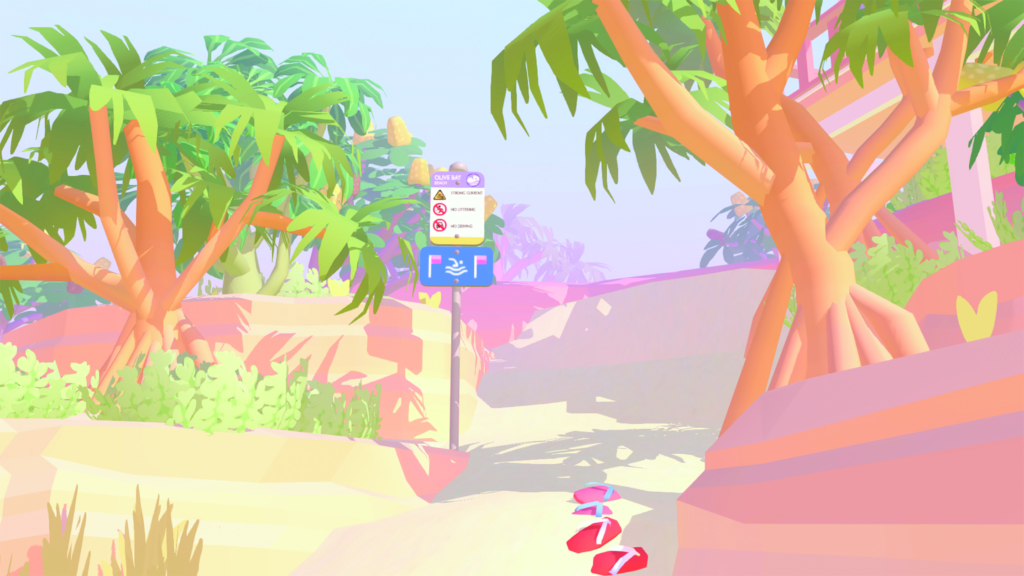
Haines took photographs when she revisited her childhood neighbourhood in order to capture the intricate details that she wished to incorporate into Surf Club.
I [was] really trying to reflect [on] and walk myself through the area that I lived in and trying to remember things I did as a kid, like going to the park and […] the national park behind the playground. I want, in the game, for you to be able to just find these little secrets in the environment.
Haines intends for players to experience an affectionate relationship with the game’s coastal setting, one that captures her own experience of living in a small town:
We could just kind of roam and get to know all the little secrets, all the little nooks and crannies […] The town [is] so small [that] everything becomes just so familiar and you know it so intimately.
Haines hopes that her inclusion of subtle secrets like this will encourage players to navigate the space with curiosity – a sentiment that reflects her own fondness for exploration and discovery as a process that drives videogame storytelling. ‘The game could have been a text-based experience or [one] with minimal gameplay,’ notes Haines; but her preference, she says, is instead to grant players the experience of contemplating their own conclusions, feelings and connection to the space.
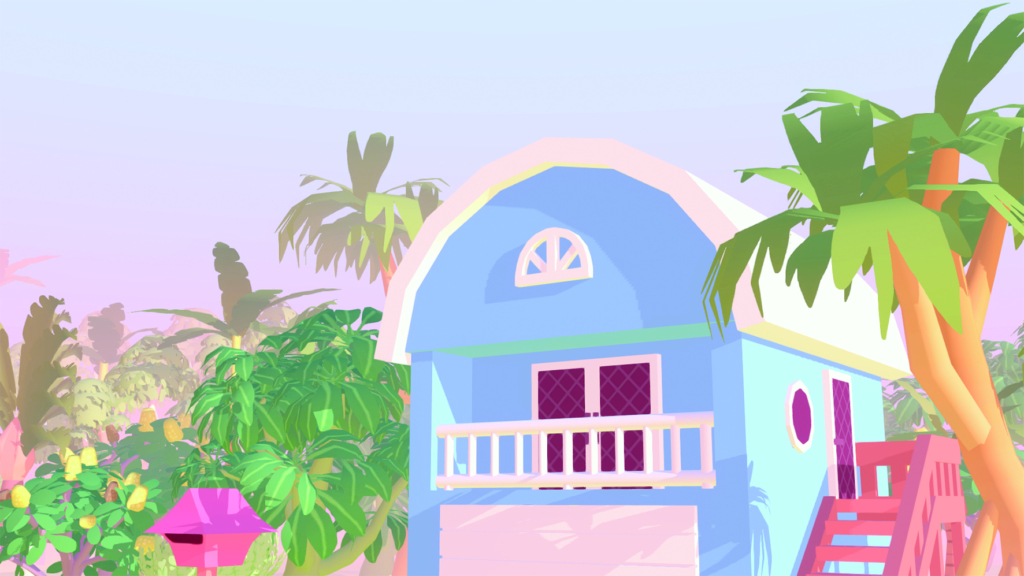
Bildungsspiel
While the coming-of-age genre[2]‘Coming-of-age’ here refers to a youth-oriented genre that deals with initiation trials and identity formation, also termed ‘bildungsroman’ in literary contexts. usually revolves around the teenage experience, Surf Club’s protagonist is in her early twenties. For Haines, this age more effectively speaks to her own formative years: ‘You just grow so much […] It’s that age, I think, [when] I noticed myself and the people around me – that’s sort of the time [when] you find your place in the world.’ As Haines has found, though, and what Surf Club communicates, is that accepting that newfound place can be difficult.
A central theme of the game is its protagonist’s homesickness, as Haines describes:
[Holly] has a lot of nostalgia for the town that she grew up in, but at the same time it’s changed a lot from when she used to live there, and she’s changed a lot as well […] Homesickness is something that I experienced – that’s a big part of coming of age for me, personally, and sort of the complicated feelings around, you know, do you throw away everything that you’re working towards and just go back and stay in this safe little bubble in a town where you don’t really belong anymore? And that’s what she has to come to terms with and face in the game.
For Haines, who herself moved out of home at the age of seventeen, this separation from familiar surroundings represented a significant trial for her own sense of self, and paralleled her independent growth as a person. She confides that she was an introverted teenager before moving to Melbourne, and that it was only with that change of scenery that she was able to begin the uneasy process of discovering her place in the world. It was also during this time, Haines says, when the coming-of-age genre began to resonate with her: ‘It was nice seeing people that were my age struggling with similar things, and these stories were always about growth. [The genre is] never really judgemental.’ She credits Submarine (Richard Ayoade, 2010) and Kiki’s Delivery Service (Hayao Miyazaki, 1989) as coming-of-age films that have influenced her game’s cosy locale and tranquil, wistful soundtrack, composed by her sole collaborator, sound designer Eli Rainsberry.
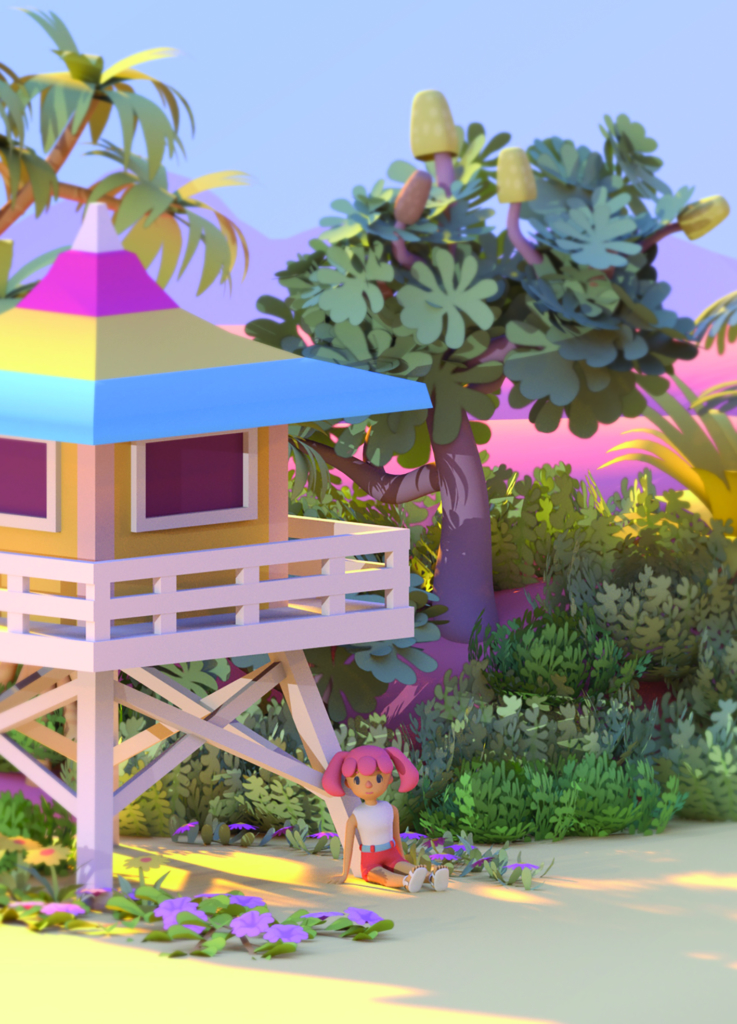
Surf Club traces change through its shifts between past and present. A vacant lot in the past, for example, now sits beneath scaffolding for a resort in the present, while a humble corner shop in the past has been transformed into a trendy cafe; Haines comments that these changes reference her observations of Noosa’s increasing commercialisation over the years. The changes mirror Holly’s own disoriented sense of self because she, too, is a different person than she was when she left.
Surf Club traces change through its shifts between past and present. A vacant lot in the past, for example, now sits beneath scaffolding for a resort in the present, while a humble corner shop in the past has been transformed into a trendy cafe.
In representing a character’s safety within a knowable environment – in contrast with the potentially overwhelming possibilities, or unknowns, available outside that comforting space – the home town often plays a fascinating role in coming-of-age narratives. Such environments can have a particularly important place in videogames: as the format allows for the creation of explorable spaces that players can familiarise themselves with and develop fondness for, there is capacity to build greater empathy for a protagonist who is hesitant to move on. A number of other coming-of-age games in recent years have explored a similar sense of displacement greeting a return home. Life Is Strange, Night in the Woods and If Found … all express a disorientation and unmet nostalgia that deeply constitute their respective heroines’ identity negotiations. Each game employs varying mechanics to communicate these themes: Life Is Strange incorporates a time-reversal device to signal its protagonist’s hold on the past; Night in the Woods experiments with mundane repetition to capture both its town’s and protagonist’s helpless standstill;[3]For an expanded analysis of homecoming and disorientation in Life Is Strange and Night in the Woods, see Stephanie Harkin, ‘The Restoration of Female Friendship in Life Is Strange and Night in the Woods’, in Lindsay D Grace (ed.), Love and Electronic Affection: A Design Primer, CRC Press, Boca Raton, Florida & Abingdon, UK, 2020, p. 111–30. and If Found … tasks players with erasing the contents of a diary that records a character’s longing for a place of acceptance. Surf Club builds on videogames’ growing engagement with this genre, adding its developer’s distinctive voice and artistic sensibility.
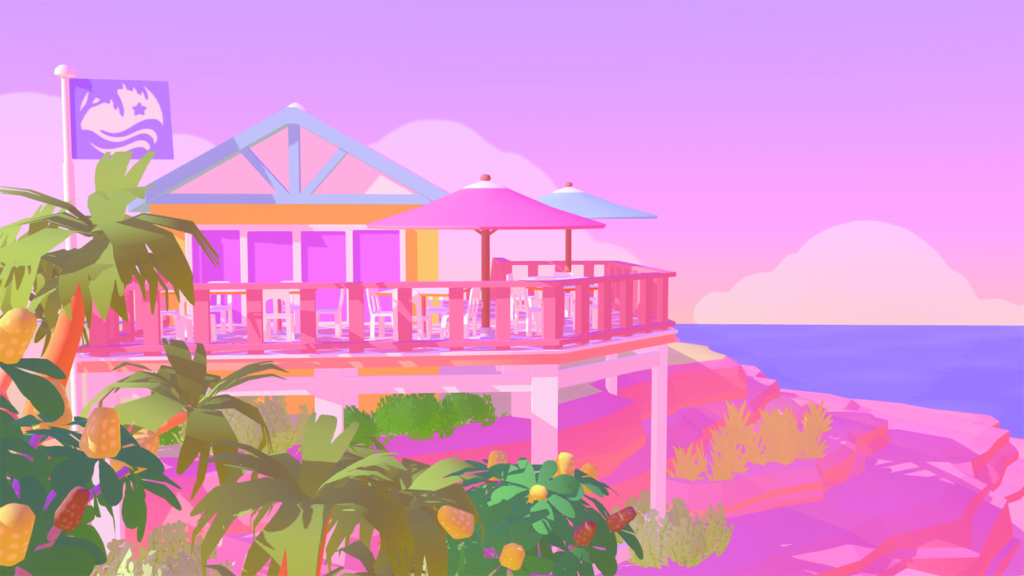
Creative breakthroughs
Although Surf Club is Haines’ first commercial project, she has already received critical praise for her short, contemplative 2020 game Terracotta.[4]See, for example, ‘Into The Spine: Best Games of 2020’, Into The Spine, 16 December 2020, <https://intothespine.com/2020/12/16/best-games-2020/>; and Jess Lee & Ali Griffiths, ‘The Best Indie Games of 2020,’ Digital Spy, 22 December 2020, <https://www.digitalspy.com/tech/a34989126/best-indie-games-2020/>, both accessed 23 August 2021. Haines describes the experimental project as a means of processing the ‘weird’ feelings brought about by Melbourne’s COVID-19 lockdown and translating thoughts ‘directly from [her] brain’. In this game, her thoughts are presented as floating text during a short walk through a dreamy pink-skied neighbourhood. While the tender contemplations explored in Terracotta differ quite dramatically from her embrace of silliness in earlier works such as 2018’s Pool Party, Surf Club strikes a balance between the serious and the playful, as Haines describes:
I don’t want it to be serious the whole way through; I want it to be fun [too], because I feel like that’s also part of Holly’s nostalgia – remembering the good times.
Haines points out that her planning process has also been comparatively more involved for this work:
With a lot of my games in the past, it’s all sort of been done at once […] But with Surf Club, because I haven’t done a big ‘story’ game before, I really wanted to give it a lot of time to be able to plan it out […] I don’t think I even opened Unity – the game engine I use – until, like, the start of [2020].
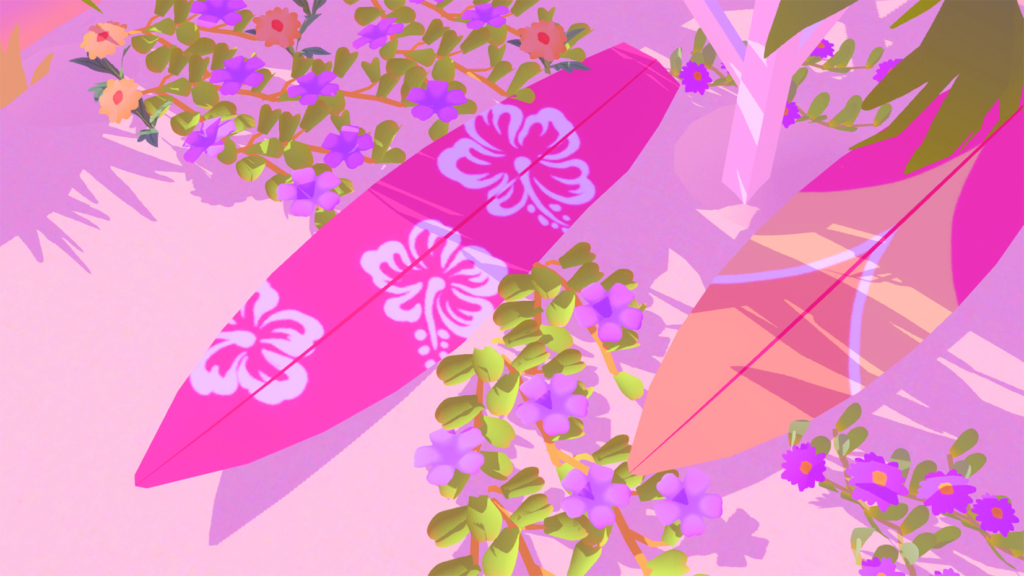
Planning a manageable scope for the game helped her receive funding support from Film Victoria, Haines believes. She also took a break from working on other people’s games and began part-time employment to dedicate focus to her own project. As videogames scholar Brendan Keogh has found, independent development has come to characterise Australia’s game making field after the 2008 Global Financial Crisis ‘decimated’ Australia’s once larger, more corporatised industry.[5]Brendan Keogh, ‘The Cultural Field of Video Game Production in Australia’, Games and Culture, vol. 16, no. 1, 2021, pp. 116–35. For Haines, the benefits of this approach to game development are clear:
I think working out my own approach to things has been really good. I think you can watch a million GDC [Game Developers Conference] talks and take other people’s advice on how to approach making your own project, but, having made my own small games, I’ve sort of got to know myself better and how I work […] I can approach each day in a way that works for me […]
I mean it’s definitely taken a long time and […] a lot of trial and error, but I wouldn’t plan to make a big game if I was worried that I couldn’t handle it or if I didn’t know myself well enough.
Surf Club is due to be released in 2022. The game will be available on itch.io and Steam, with plans to attain a release on Nintendo Switch and PlayStation consoles.
Endnotes
| 1 | Haines’ earlier works can be accessed via her developer page. See <https://livvy.itch.io/>, accessed 23 August 2021. |
|---|---|
| 2 | ‘Coming-of-age’ here refers to a youth-oriented genre that deals with initiation trials and identity formation, also termed ‘bildungsroman’ in literary contexts. |
| 3 | For an expanded analysis of homecoming and disorientation in Life Is Strange and Night in the Woods, see Stephanie Harkin, ‘The Restoration of Female Friendship in Life Is Strange and Night in the Woods’, in Lindsay D Grace (ed.), Love and Electronic Affection: A Design Primer, CRC Press, Boca Raton, Florida & Abingdon, UK, 2020, p. 111–30. |
| 4 | See, for example, ‘Into The Spine: Best Games of 2020’, Into The Spine, 16 December 2020, <https://intothespine.com/2020/12/16/best-games-2020/>; and Jess Lee & Ali Griffiths, ‘The Best Indie Games of 2020,’ Digital Spy, 22 December 2020, <https://www.digitalspy.com/tech/a34989126/best-indie-games-2020/>, both accessed 23 August 2021. |
| 5 | Brendan Keogh, ‘The Cultural Field of Video Game Production in Australia’, Games and Culture, vol. 16, no. 1, 2021, pp. 116–35. |
